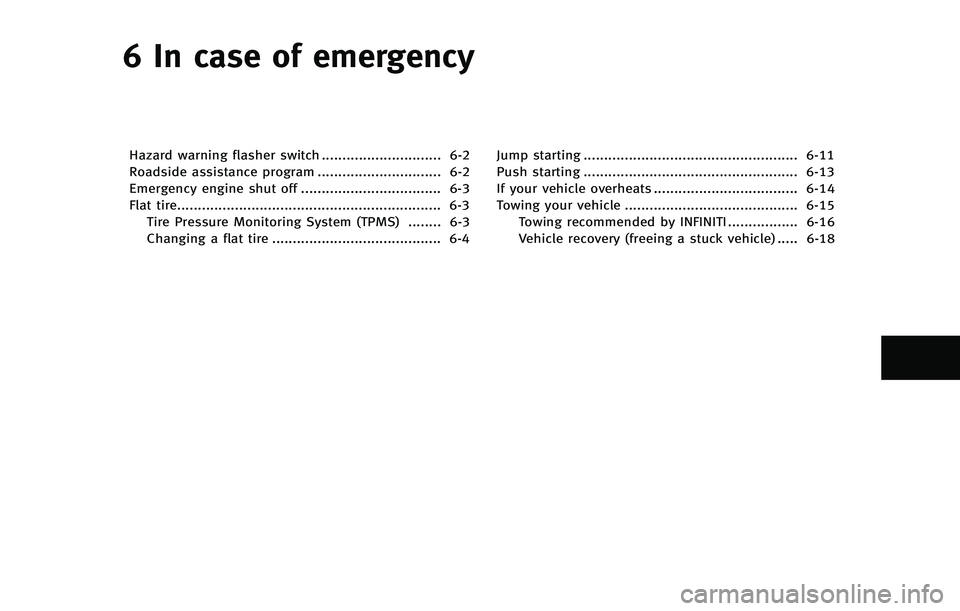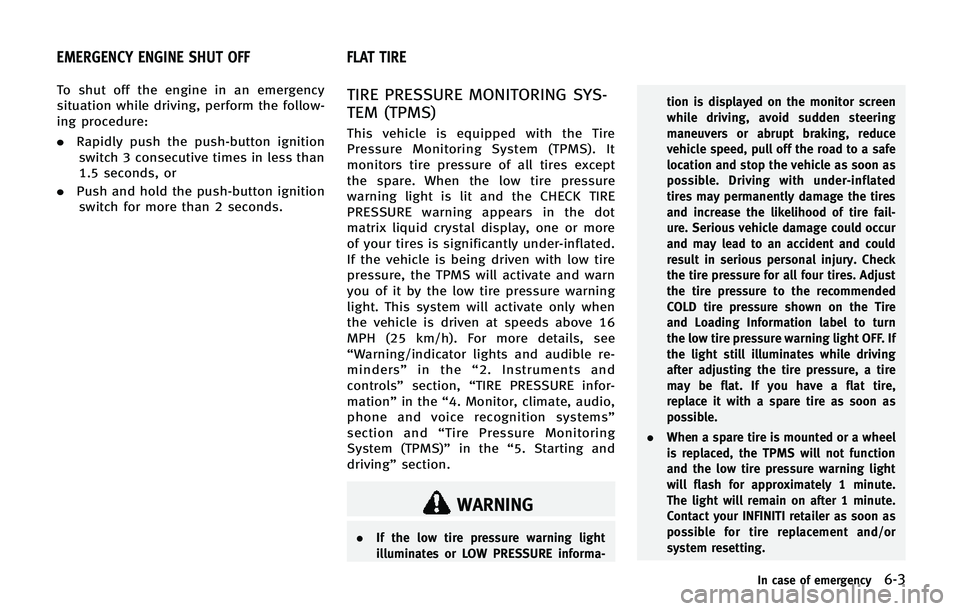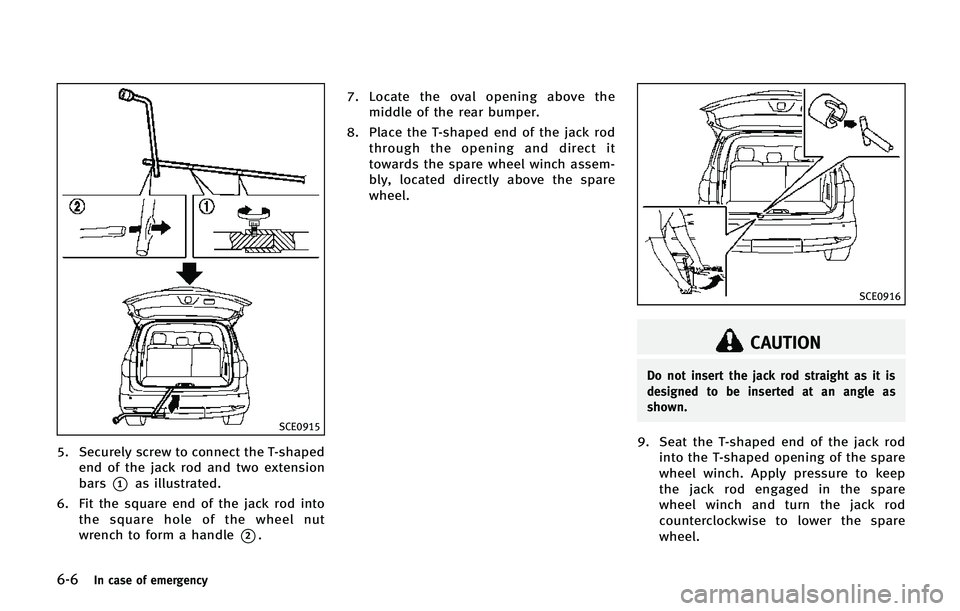INFINITI QX80 2014 Owners Manual
Manufacturer: INFINITI, Model Year: 2014, Model line: QX80, Model: INFINITI QX80 2014Pages: 578, PDF Size: 2.8 MB
Page 461 of 578

5-120Starting and driving
MEMO
Page 462 of 578

6 In case of emergency
Hazard warning flasher switch ............................. 6-2
Roadside assistance program .............................. 6-2
Emergency engine shut off .................................. 6-3
Flat tire................................................................ 6-3Tire Pressure Monitoring System (TPMS) ........ 6-3
Changing a flat tire ......................................... 6-4 Jump starting .................................................... 6-11
Push starting .................................................... 6-13
If your vehicle overheats ................................... 6-14
Towing your vehicle .......................................... 6-15
Towing recommended by INFINITI ................. 6-16
Vehicle recovery (freeing a stuck vehicle) ..... 6-18
Page 463 of 578

6-2In case of emergency
SIC2574
Push the switch on to warn other drivers
when you must stop or park under
emergency conditions. All turn signal lights
will flash.
WARNING
.If stopping for an emergency, be sure to
move the vehicle well off the road.
. Do not use the hazard warning flashers
while moving on the highway unless
unusual circumstances force you to drive
so slowly that your vehicle might be-
come a hazard to other traffic. .
Turn signals do not work when the
hazard warning flasher lights are on.
The flasher can be actuated with the
ignition switch in any position.
When an impact that could activate the
supplemental air bags is detected, the
hazard warning flasher lights blink auto-
matically. If the hazard warning flasher
switch is pushed twice, the hazard warning
flashers will turn off.
WARNING
Do not turn the hazard warning flasher
switch to off until you can make sure that it
is safe to do so. Also, the hazard flasher
warning may not blink automatically de-
pending on the force of impact.
Some state laws may prohibit the use of
the hazard warning flasher switch while
driving. In the event of a roadside emergency,
Roadside Assistance Service is available to
you. Please refer to your Warranty Informa-
tion Booklet (U.S.) or Warranty & Roadside
Assistance Information Booklet (Canada)
for details.
HAZARD WARNING FLASHER SWITCH
ROADSIDE ASSISTANCE PROGRAM
Page 464 of 578

To shut off the engine in an emergency
situation while driving, perform the follow-
ing procedure:
.Rapidly push the push-button ignition
switch 3 consecutive times in less than
1.5 seconds, or
. Push and hold the push-button ignition
switch for more than 2 seconds.TIRE PRESSURE MONITORING SYS-
TEM (TPMS)
This vehicle is equipped with the Tire
Pressure Monitoring System (TPMS). It
monitors tire pressure of all tires except
the spare. When the low tire pressure
warning light is lit and the CHECK TIRE
PRESSURE warning appears in the dot
matrix liquid crystal display, one or more
of your tires is significantly under-inflated.
If the vehicle is being driven with low tire
pressure, the TPMS will activate and warn
you of it by the low tire pressure warning
light. This system will activate only when
the vehicle is driven at speeds above 16
MPH (25 km/h). For more details, see
“Warning/indicator lights and audible re-
minders” in the“2. Instruments and
controls” section,“TIRE PRESSURE infor-
mation” in the“4. Monitor, climate, audio,
phone and voice recognition systems”
section and “Tire Pressure Monitoring
System (TPMS)” in the“5. Starting and
driving” section.
WARNING
.If the low tire pressure warning light
illuminates or LOW PRESSURE informa- tion is displayed on the monitor screen
while driving, avoid sudden steering
maneuvers or abrupt braking, reduce
vehicle speed, pull off the road to a safe
location and stop the vehicle as soon as
possible. Driving with under-inflated
tires may permanently damage the tires
and increase the likelihood of tire fail-
ure. Serious vehicle damage could occur
and may lead to an accident and could
result in serious personal injury. Check
the tire pressure for all four tires. Adjust
the tire pressure to the recommended
COLD tire pressure shown on the Tire
and Loading Information label to turn
the low tire pressure warning light OFF. If
the light still illuminates while driving
after adjusting the tire pressure, a tire
may be flat. If you have a flat tire,
replace it with a spare tire as soon as
possible.
. When a spare tire is mounted or a wheel
is replaced, the TPMS will not function
and the low tire pressure warning light
will flash for approximately 1 minute.
The light will remain on after 1 minute.
Contact your INFINITI retailer as soon as
possible for tire replacement and/or
system resetting.
In case of emergency6-3
EMERGENCY ENGINE SHUT OFF FLAT TIRE
Page 465 of 578

6-4In case of emergency
.Replacing tires with those not originally
specified by INFINITI could affect the
proper operation of the TPMS.
. Do not inject any tire liquid or aerosol
tire sealant into the tires, as this may
cause a malfunction of the tire pressure
sensors.
CHANGING A FLAT TIRE
If you have a flat tire, follow the instruc-
tions below.
Stopping the vehicle
1. Safely move the vehicle off the road
and away from traffic.
2. Turn on the hazard warning flashers.
3. Park on a level surface and apply the parking brake. Move the shift lever to
the P (Park) position.
4. Turn off the engine.
5. Raise the hood to warn other traffic, and to signal professional road assis-
tance personnel that you need assis-
tance.
6. Have all passengers get out of the vehicle and stand in a safe place, away
from traffic and clear of the vehicle.
WARNING
. Make sure the parking brake is securely
applied and the automatic transmission
is in the P (Park) position.
. Never change tires when the vehicle is
on a slope, ice or slippery areas. This is
hazardous.
. Never change tires if oncoming traffic is
close to your vehicle. Wait for profes-
sional road assistance.
MCE0001A
Blocking wheels
Place suitable blocks*1at both the front
and back of the wheel diagonally opposite
the flat tire to prevent the vehicle from
moving when it is jacked up.
WARNING
Be sure to block the wheel as the vehicle
may move and result in personal injury.
Page 466 of 578

JVE0023X
Getting the spare tire and tools
1. Open the lift gate.
2. Raise the cargo floor board using thehandle
*A.
JVE0091X
WARNING
When removing jacking tools, be sure the
rubber sound suppressor*1, used to
control jack stand from rattling against
metal, is not attached to the jacking tool. If rubber sound suppressor remains on jack
when vehicle is being jacked up, the vehicle
will be unstable and may fall off jack stand
causing serious injury of death.
3. Remove the cargo floor cover.
4. Remove the jacking tools.
In case of emergency6-5
Page 467 of 578

6-6In case of emergency
SCE0915
5. Securely screw to connect the T-shapedend of the jack rod and two extension
bars
*1as illustrated.
6. Fit the square end of the jack rod into the square hole of the wheel nut
wrench to form a handle
*2. 7. Locate the oval opening above the
middle of the rear bumper.
8. Place the T-shaped end of the jack rod through the opening and direct it
towards the spare wheel winch assem-
bly, located directly above the spare
wheel.
SCE0916
CAUTION
Do not insert the jack rod straight as it is
designed to be inserted at an angle as
shown.
9. Seat the T-shaped end of the jack rodinto the T-shaped opening of the spare
wheel winch. Apply pressure to keep
the jack rod engaged in the spare
wheel winch and turn the jack rod
counterclockwise to lower the spare
wheel.
Page 468 of 578

SCE0377
10. Once the spare wheel is completelylowered, remove the jack rod and reach
under the vehicle to remove the hang-
ing plate.
11. Carefully slide the spare wheel from under the rear of the vehicle.
After preparing the spare tire, to remove
the rod, pull out the rod while moving the
rod to the right and left with the screw of
the extension facing the side.
CAUTION
When storing the wheel, make sure that the
hanging plate is in the center of the wheel
and then lift it up into the storage area.
SCE0917
CAUTION
When storing the wheel, be sure to mount
the wheel horizontally. Securing the wheel
that is in a tilted position as illustrated may
cause looseness and dropping of the wheel
In case of emergency6-7
Page 469 of 578

6-8In case of emergency
while driving. Lower the wheel on the
ground again, and make sure that the
hanging plate is properly set. Hang the
wheel again and make sure that the wheel is
held horizontally, then store the wheel.
Jacking up the vehicle and remov-
ing the damaged tire
WARNING
.Never get under the vehicle while it is
supported only by the jack. If it is
necessary to work under the vehicle,
support it with safety stands.
. Use only the jack provided with your
vehicle to lift the vehicle. Do not use the
jack provided with your vehicle on other
vehicles. The jack is designed for lifting
only your vehicle during a tire change.
. Use the correct jack-up points. Never use
any other part of the vehicle for jack
support.
. Never jack up the vehicle more than
necessary.
. Never use blocks on or under the jack. .
Do not start or run the engine while
vehicle is on the jack, as it may cause
the vehicle to move. This is especially
true for vehicles with limited slip differ-
entials.
. Do not allow passengers to stay in the
vehicle while it is on the jack.
Carefully read the caution label attached to
the jack body and the following instruc-
tions.
SCE0875
Jack-up point
1. Place the jack directly under the jack-up
points as illustrated.
The jack should be used on level firm
ground.
Page 470 of 578

SCE0876
2. Loosen each wheel nut one or two turnsby turning counterclockwise with the
wheel nut wrench. Do not remove the
wheel nuts until the tire is off the
ground.
NCE130
3. Install the assembled jack rod into the
jack as shown.
4. Carefully raise the vehicle until the clearance between the tire and ground
is achieved.
5. To lift the vehicle, securely hold the jack lever and rod with both hands and
turn the jack lever.
NOTE:
Before jacking up the vehicle, make sure
the ignition switch is placed in the OFF
position. If the vehicle is lifted up with the
engine running, the auto-leveling suspen-
sion will become disabled after 120
In case of emergency6-9